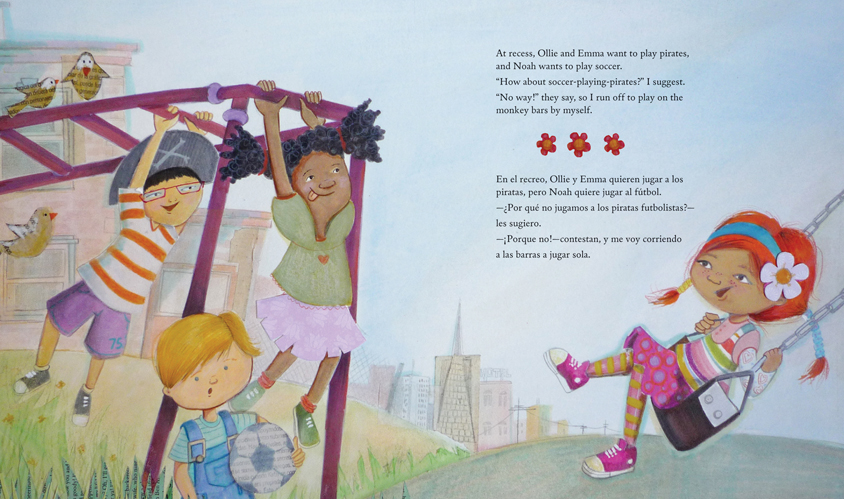Marisol McDonald Doesn't Match is written by Monica Brown and illustrated by Sara Palacois. It was published in 2011 by Regent Publishing.
Lexile Level: AD580L Ages: 5-7
Summary:
Marisol McDonald has orange-red hair and nut-brown skin. Polka dots and stripes are one of her favorite clothing combinations to wear. To Marisol, being mismatched makes perfect sense. Other people are confused about Marisol and try to get her to change. Marisol's friends present a challenge "You couldn't match if you wanted to!" So the next day Marisol takes up the challenge and tries to conform. She wears clothes that are all the same color and plays only pirates at recess. Marisol realizes that she has to be true to herself, so the next day she puts on her favorite mismatched outfit and declares "My name is Marisol McDonald and I don't want match because ... I don't want to!"And when she finally gets a long-promised puppy, he is a perfect fit.Evaluation:
This book is a good for English language learners because each page is written in English and Spanish. (shown in the image below). Bilingual books facilitate connections by visually contrasting the two languages. You open the book and there they are, right in front of you. The student doesn’t have to spend hours trying to decipher the language in order to understand the content. Instead, with a little bit of preparation in the stronger language, they can focus their attention on building up the weaker language.The message of this book is powerful because it is showing individuality. Marisol is made fun of because of the way she dresses, the food she eats, the games she plays at recess, and the art she creates. Others don't stop her though she is a little girl who loves herself. When her friends don't want to play with her, she makes fun by herself. Ms. Apple, the teacher, gives her a note that tells her she likes her just the way she is.That shows Marisol that individuality is great and she can be mismatched and happy.
Illustrations and elements:
Monica Brown shows a variety of themes in Marisol McDonald Doesn't Match those are diversity, family, identity, compassion and obstacles. Marisol's family is a large part of her life and they support her and her choice to mismatch. She faces the obstacle of being judged by her classmates for being mismatched but she overcomes this obstacle from the support of her family and teacher. The style of writing is first person. The quality of writing is simple with both narrative and character dialogue. The setting of this story is at Marisol's school, home, and on the playground with a wide range of characters. There is Marisol, Ms. Apple, Marisol's friends, Ollie, Marisol's parents, and Kitty the dog.1. Themes: diversity, family, identity, compassion, and obstacles
2. Style of writing: first person
3. Setting: Marisol's home, school, and the play ground
The illustrations show the different cultures of Marisol's family. Marisol has red hair from her Scottish heritage (her dad's side) and darker skin from her Peruvian heritage (her mom's side). Marisol speaks both English and Spanish. She eats foods that are both North American and South American mixed together and the illustrator Sara Palacios does a wonderful job showing the clear cultural differences.
In the Classroom:
After the students read this book, hopefully they will understand the beauty of cultural differences and Marisol McDonald Doesn't Match encourages happiness in uniqueness. A lesson the class could so is...Have students participate in a unique art lesson where everyone follows the same directions in their own way. The directions include:
- Draw four straight lines from one side of the paper to the other.
- Draw five circles anywhere on the paper.
- Draw one curved line that starts at one edge of the paper and ends somewhere in the middle of the paper.
- Color in two of the circles.
- Fill in three areas of the paper by drawing squiggles, geometric shapes, or whatever you like.
Brown, M., & Palacios, S. (2011). Marisol McDonald Doesn't Match. Regent Publishing.


No comments:
Post a Comment